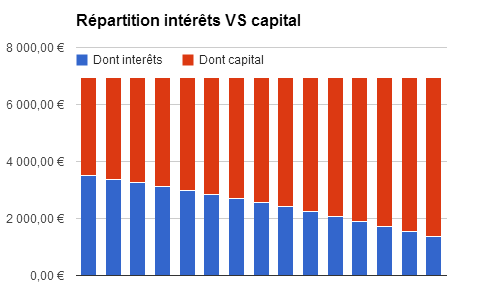When we talk about real estate loans, we often hear this sentence indicating that the bank pays itself first , that these bad bankers get paid first . The line is exaggerated, but the idea is there. Is there any truth behind this recurring assertion? So finally, why do we say that?
First thing to remember: it is the bank that puts the money on the table , the money that you are missing and/or that you need for your real estate project. And therefore, yes, the bank pays itself first. It is therefore logical that it is the first to be paid on this advance. Of course, this only engages me, but the approach does not shock me at all.
Beyond this short aside, why do we say that the bank pays itself first? Quite simply because at the start of a mortgage, we often repay most of the interest on this loan. In the first months or years of a mortgage, the share of capital repaid sometimes seems derisory compared to the monthly loan payment repaid. The explanation is logical and mathematical, quite simply…
Let’s take the example of a person who has borrowed €100,000 all round from his bank. This amount was borrowed over 20 years at a rate of 3.5% . The monthly payment to be paid throughout this period will be €580 (calculated on Empruntis.com), i.e. €6,960 per year. For reasons of simplification, loan insurance is excluded from the calculation.
Reported to the year, the loan amortization table could look like this:
The first years, the interests would count in our case study for nearly 50% of the monthly payment .
At the beginning of the first year, no capital has yet been repaid, so there remains €100,000 of capital. The borrowing rate being 3.5%, 3.5% of these €100,000 will be repaid over the year , i.e. €3,500, or just over €291 per month (€3,500 / 12 months) on a fixed monthly payment of €580. The rest of the monthly payment will therefore be used to repay the borrowed capital, i.e. €3,460 over the year (€6,960 for our 12 monthly payments, less €3,500 in interest), or a little more than €288 each month.
The second year, the remaining capital will be equal to the capital initially borrowed, minus the part repaid the first year, i.e. €100,000 – €3,460, i.e. €96,440. It is then 3.5% of this new outstanding capital that will be payable over the year, i.e. €3,378.90 or just under €282 per month. Again, the rest of the monthly payment will repay the capital, or around €3,581 over the year for just over €298 per month.
And so on from year to year. Over time, the distribution of interest VS capital will be as follows:
Finally, the general principle is as follows: it is simply a question of applying the borrowing rate to the capital remaining due at the beginning of each year to know the amount of interest that will be reimbursed, and therefore consequently the share of capital that will be repaid over the year, the monthly payment being constant over time.
Let’s recap:
In the example taken, the interest/capital ratio is approximately 50% at the start of the mortgage. Other figures could have given a much less balanced distribution, in particular a higher borrowing rate! In any case, it is wrong to say that we only pay the loan interest at the start of the loan and only the capital at the end of the loan!
And you, have you already studied the amortization table of your mortgage in more detail?


